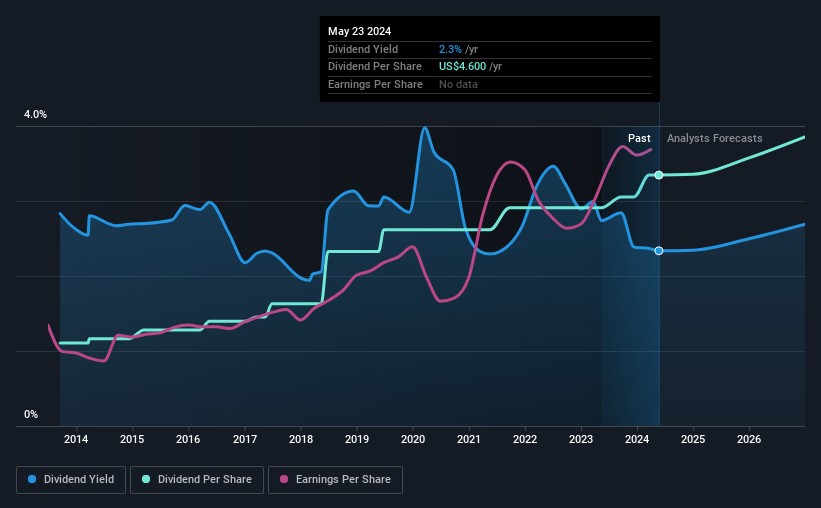JPMorgan Chase (NYSE:JPM) Has Announced A Dividend Of $1.15
The board of JPMorgan Chase & Co. (NYSE:JPM) has announced that it will pay a dividend on the 31st of July, with investors receiving $1.15 per share. This takes the annual payment to 2.3% of the current stock price, which unfortunately is below what the industry is paying.
See our latest analysis for JPMorgan Chase
JPMorgan Chase's Earnings Will Easily Cover The Distributions
It would be nice for the yield to be higher, but we should also check if higher levels of dividend payment would be sustainable.
Having distributed dividends for at least 10 years, JPMorgan Chase has a long history of paying out a part of its earnings to shareholders. Taking data from its last earnings report, calculating for the company's payout ratio shows 26%, which means that JPMorgan Chase would be able to pay its last dividend without pressure on the balance sheet.
Looking forward, EPS is forecast to rise by 4.9% over the next 3 years. Analysts estimate the future payout ratio will be 30% over the same time period, which is in the range that makes us comfortable with the sustainability of the dividend.
JPMorgan Chase Has A Solid Track Record
The company has a sustained record of paying dividends with very little fluctuation. The annual payment during the last 10 years was $1.52 in 2014, and the most recent fiscal year payment was $4.60. This means that it has been growing its distributions at 12% per annum over that time. It is good to see that there has been strong dividend growth, and that there haven't been any cuts for a long time.
The Dividend Looks Likely To Grow
Some investors will be chomping at the bit to buy some of the company's stock based on its dividend history. It's encouraging to see that JPMorgan Chase has been growing its earnings per share at 13% a year over the past five years. Growth in EPS bodes well for the dividend, as does the low payout ratio that the company is currently reporting.
JPMorgan Chase Looks Like A Great Dividend Stock
In summary, it is always positive to see the dividend being increased, and we are particularly pleased with its overall sustainability. The company is easily earning enough to cover its dividend payments and it is great to see that these earnings are being translated into cash flow. All of these factors considered, we think this has solid potential as a dividend stock.
Investors generally tend to favour companies with a consistent, stable dividend policy as opposed to those operating an irregular one. At the same time, there are other factors our readers should be conscious of before pouring capital into a stock. For example, we've identified 2 warning signs for JPMorgan Chase (1 is concerning!) that you should be aware of before investing. Is JPMorgan Chase not quite the opportunity you were looking for? Why not check out our selection of top dividend stocks.
Have feedback on this article? Concerned about the content? Get in touch with us directly. Alternatively, email editorial-team (at) simplywallst.com.
This article by Simply Wall St is general in nature. We provide commentary based on historical data and analyst forecasts only using an unbiased methodology and our articles are not intended to be financial advice. It does not constitute a recommendation to buy or sell any stock, and does not take account of your objectives, or your financial situation. We aim to bring you long-term focused analysis driven by fundamental data. Note that our analysis may not factor in the latest price-sensitive company announcements or qualitative material. Simply Wall St has no position in any stocks mentioned.

 Yahoo Finance
Yahoo Finance 
